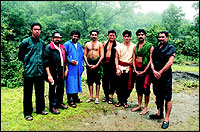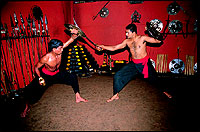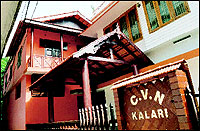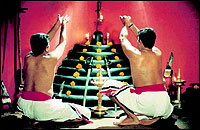IT is 7 o'clock in the morning and I am outside the C.V.N. Kalari institute at Nadakkavu in Calicut, about to enter and witness a vibrant art that has influenced the development of Kerala�s traditional theatre forms. It is a bright, cheerful-looking wood and cement building that strangely makes me think of the legendary Shaolin Temple in China. Perhaps, because both are renowned learning grounds of traditional martial arts forms. But while the Shaolin Temple is guarded about who it teaches Kung-fu, the C.V.N. Kalari institute will teach anybody interested in the ancient Kerala martial art form Kalaripayattu.
 Sunil Kumar, one of the three instructors here, says that many foreigners come to learn Kalaripayattu at the institute. �Several foreign martial artists, too, and people from the world of theatre and films, because Kalaripayattu is a classical art form. It improves flexibility of the body and makes movements fluid and easy,� he explains. �It also helps in choreographing dance numbers.� His father, Sri Narayanan Gurukkal, introduced Kalaripayattu to Calicut 55 years ago. He then took it places, propagated it over the world through stage presentations, lectures and demonstrations, gaining the attention of the international community. When the master passed away in 2000, the tradition continued with his sons Anil, Sunil and Gopan.
Sunil Kumar, one of the three instructors here, says that many foreigners come to learn Kalaripayattu at the institute. �Several foreign martial artists, too, and people from the world of theatre and films, because Kalaripayattu is a classical art form. It improves flexibility of the body and makes movements fluid and easy,� he explains. �It also helps in choreographing dance numbers.� His father, Sri Narayanan Gurukkal, introduced Kalaripayattu to Calicut 55 years ago. He then took it places, propagated it over the world through stage presentations, lectures and demonstrations, gaining the attention of the international community. When the master passed away in 2000, the tradition continued with his sons Anil, Sunil and Gopan.
 I understand many famous Indian dancers like Astad Deboo, Daksha Sheth, Asha Coorlawala and Mallika Sarabhai use Kalaripayattu to enrich their language of expression and to devise newer, brighter, stronger, individualistic artistic idioms with remarkable success. To prove a point, Sunil shows me an album of pictures of some of the institute�s star students. I recognise a few of them. Then, he shows me a picture of himself and some other Kalaripayattu fighters on the sets of Asoka with Shah Rukh Khan. �I trained him for the fight scenes,� Sunil says. �I also trained Akshay Kumar.�
I understand many famous Indian dancers like Astad Deboo, Daksha Sheth, Asha Coorlawala and Mallika Sarabhai use Kalaripayattu to enrich their language of expression and to devise newer, brighter, stronger, individualistic artistic idioms with remarkable success. To prove a point, Sunil shows me an album of pictures of some of the institute�s star students. I recognise a few of them. Then, he shows me a picture of himself and some other Kalaripayattu fighters on the sets of Asoka with Shah Rukh Khan. �I trained him for the fight scenes,� Sunil says. �I also trained Akshay Kumar.�
 Meanwhile, it is time for the Kalaripayattu demonstration, and Sunil�s students start entering the institute dressed in loose black, flowing pajamas with a six-yard long cotton cloth tightly wound around the abdomen. The training area is unlike any martial arts dojo I have seen. The floor is hard earth, not soft and slushly like a kusti akhada in Maharashtra. The presiding deity of the kalari institute is Bharadevata. The south-west corner of the training area is the sacred seat of Bharadevata. The corner is known as the poothara and has seven sacred steps leading to a small raised platform. Here, offerings of flowers and the sacred tulsi are kept.
Meanwhile, it is time for the Kalaripayattu demonstration, and Sunil�s students start entering the institute dressed in loose black, flowing pajamas with a six-yard long cotton cloth tightly wound around the abdomen. The training area is unlike any martial arts dojo I have seen. The floor is hard earth, not soft and slushly like a kusti akhada in Maharashtra. The presiding deity of the kalari institute is Bharadevata. The south-west corner of the training area is the sacred seat of Bharadevata. The corner is known as the poothara and has seven sacred steps leading to a small raised platform. Here, offerings of flowers and the sacred tulsi are kept.
 The kalari gurukkal (teacher) is revered as the representative of the deity and is considered as the living embodiment of a long line of respected gurus. In the C.V.N. Kalari institute, I did not know whether this was the late Sri Narayanan Gurukkal or any of his sons. For all the students prostrated at the feet of Sunil, but they also bowed in reverence before a framed photograph of Sri Narayanan Gurukkal. No matter. They were soon performing maipayattu, a number of basic exercises whose constant and regular practise results in controlled, flexible and graceful movements of the body for defence and offence. Steps, stances as well as breath-control are included in these exercises.
The kalari gurukkal (teacher) is revered as the representative of the deity and is considered as the living embodiment of a long line of respected gurus. In the C.V.N. Kalari institute, I did not know whether this was the late Sri Narayanan Gurukkal or any of his sons. For all the students prostrated at the feet of Sunil, but they also bowed in reverence before a framed photograph of Sri Narayanan Gurukkal. No matter. They were soon performing maipayattu, a number of basic exercises whose constant and regular practise results in controlled, flexible and graceful movements of the body for defence and offence. Steps, stances as well as breath-control are included in these exercises.
 That done, the students, with Sunil giving the lead, leap into frenzied combat situations among themselves using a range of sticks from one-and-half feet long to six feet. I watch, fascinated, as they make determined assaults on each other with lightning speed. The sticks are then replaced by even more intricate and dangerous weapons. Like daggers, swords, spears, mace, axes, knives and flexible swords that are all decorating the walls and floor of the institute. The students pick up shields and attack each other murderously and with a frightful clanging of their weapons. They then follow this with defence tactics against armed attacks. I flinch when I see that Sunil is bleeding from a gash on the elbow suffered during his sword fight with a student. �Not a problem,� he tells me, �I am trained in ayurveda to treat accidental injuries.�
That done, the students, with Sunil giving the lead, leap into frenzied combat situations among themselves using a range of sticks from one-and-half feet long to six feet. I watch, fascinated, as they make determined assaults on each other with lightning speed. The sticks are then replaced by even more intricate and dangerous weapons. Like daggers, swords, spears, mace, axes, knives and flexible swords that are all decorating the walls and floor of the institute. The students pick up shields and attack each other murderously and with a frightful clanging of their weapons. They then follow this with defence tactics against armed attacks. I flinch when I see that Sunil is bleeding from a gash on the elbow suffered during his sword fight with a student. �Not a problem,� he tells me, �I am trained in ayurveda to treat accidental injuries.�
 It turns out the C.V.N. Kalari institute also specialises in massage and ayurvedic treatment as part of its system. Muscular injuries, broken bones, joint pains, spondylitis, lumbago, arthritis, rheumatic diseases, all these are treated by Sunil and his brothers with massage using medicated oils and pastes specially prepared by Kalaripayattu masters. C.V.N. Kalari has a team of masseurs, masters and doctors who offer ayurvedic treatment and rejuvenation packages that are apart from the traditional martial arts form.
It turns out the C.V.N. Kalari institute also specialises in massage and ayurvedic treatment as part of its system. Muscular injuries, broken bones, joint pains, spondylitis, lumbago, arthritis, rheumatic diseases, all these are treated by Sunil and his brothers with massage using medicated oils and pastes specially prepared by Kalaripayattu masters. C.V.N. Kalari has a team of masseurs, masters and doctors who offer ayurvedic treatment and rejuvenation packages that are apart from the traditional martial arts form.
The C.V.N. Kalari institute teaches about 50 students at a time in four batches, morning and evening. The fees are minimal, it is Rs. 100 a month and more a dakshana (offering). �To be a complete Kalaripayattu artiste would take a person upto ten years,� says Sunil.
C.V.N. Kalari
Nadakkavu, Calicut 673011
Kerala. Phone: 0495 769114/768214.
Website: www.cvnkalarikerala.com
E-mail: [email protected]
[email protected]





 Kalari Of Calicut
Kalari Of Calicut
 Sunil Kumar, one of the three instructors here, says that many foreigners come to learn Kalaripayattu at the institute. �Several foreign martial artists, too, and people from the world of theatre and films, because Kalaripayattu is a classical art form. It improves flexibility of the body and makes movements fluid and easy,� he explains. �It also helps in choreographing dance numbers.� His father, Sri Narayanan Gurukkal, introduced Kalaripayattu to Calicut 55 years ago. He then took it places, propagated it over the world through stage presentations, lectures and demonstrations, gaining the attention of the international community. When the master passed away in 2000, the tradition continued with his sons Anil, Sunil and Gopan.
Sunil Kumar, one of the three instructors here, says that many foreigners come to learn Kalaripayattu at the institute. �Several foreign martial artists, too, and people from the world of theatre and films, because Kalaripayattu is a classical art form. It improves flexibility of the body and makes movements fluid and easy,� he explains. �It also helps in choreographing dance numbers.� His father, Sri Narayanan Gurukkal, introduced Kalaripayattu to Calicut 55 years ago. He then took it places, propagated it over the world through stage presentations, lectures and demonstrations, gaining the attention of the international community. When the master passed away in 2000, the tradition continued with his sons Anil, Sunil and Gopan. I understand many famous Indian dancers like Astad Deboo, Daksha Sheth, Asha Coorlawala and Mallika Sarabhai use Kalaripayattu to enrich their language of expression and to devise newer, brighter, stronger, individualistic artistic idioms with remarkable success. To prove a point, Sunil shows me an album of pictures of some of the institute�s star students. I recognise a few of them. Then, he shows me a picture of himself and some other Kalaripayattu fighters on the sets of Asoka with Shah Rukh Khan. �I trained him for the fight scenes,� Sunil says. �I also trained Akshay Kumar.�
I understand many famous Indian dancers like Astad Deboo, Daksha Sheth, Asha Coorlawala and Mallika Sarabhai use Kalaripayattu to enrich their language of expression and to devise newer, brighter, stronger, individualistic artistic idioms with remarkable success. To prove a point, Sunil shows me an album of pictures of some of the institute�s star students. I recognise a few of them. Then, he shows me a picture of himself and some other Kalaripayattu fighters on the sets of Asoka with Shah Rukh Khan. �I trained him for the fight scenes,� Sunil says. �I also trained Akshay Kumar.�  Meanwhile, it is time for the Kalaripayattu demonstration, and Sunil�s students start entering the institute dressed in loose black, flowing pajamas with a six-yard long cotton cloth tightly wound around the abdomen. The training area is unlike any martial arts dojo I have seen. The floor is hard earth, not soft and slushly like a kusti akhada in Maharashtra. The presiding deity of the kalari institute is Bharadevata. The south-west corner of the training area is the sacred seat of Bharadevata. The corner is known as the poothara and has seven sacred steps leading to a small raised platform. Here, offerings of flowers and the sacred tulsi are kept.
Meanwhile, it is time for the Kalaripayattu demonstration, and Sunil�s students start entering the institute dressed in loose black, flowing pajamas with a six-yard long cotton cloth tightly wound around the abdomen. The training area is unlike any martial arts dojo I have seen. The floor is hard earth, not soft and slushly like a kusti akhada in Maharashtra. The presiding deity of the kalari institute is Bharadevata. The south-west corner of the training area is the sacred seat of Bharadevata. The corner is known as the poothara and has seven sacred steps leading to a small raised platform. Here, offerings of flowers and the sacred tulsi are kept.  The kalari gurukkal (teacher) is revered as the representative of the deity and is considered as the living embodiment of a long line of respected gurus. In the C.V.N. Kalari institute, I did not know whether this was the late Sri Narayanan Gurukkal or any of his sons. For all the students prostrated at the feet of Sunil, but they also bowed in reverence before a framed photograph of Sri Narayanan Gurukkal. No matter. They were soon performing maipayattu, a number of basic exercises whose constant and regular practise results in controlled, flexible and graceful movements of the body for defence and offence. Steps, stances as well as breath-control are included in these exercises.
The kalari gurukkal (teacher) is revered as the representative of the deity and is considered as the living embodiment of a long line of respected gurus. In the C.V.N. Kalari institute, I did not know whether this was the late Sri Narayanan Gurukkal or any of his sons. For all the students prostrated at the feet of Sunil, but they also bowed in reverence before a framed photograph of Sri Narayanan Gurukkal. No matter. They were soon performing maipayattu, a number of basic exercises whose constant and regular practise results in controlled, flexible and graceful movements of the body for defence and offence. Steps, stances as well as breath-control are included in these exercises. That done, the students, with Sunil giving the lead, leap into frenzied combat situations among themselves using a range of sticks from one-and-half feet long to six feet. I watch, fascinated, as they make determined assaults on each other with lightning speed. The sticks are then replaced by even more intricate and dangerous weapons. Like daggers, swords, spears, mace, axes, knives and flexible swords that are all decorating the walls and floor of the institute. The students pick up shields and attack each other murderously and with a frightful clanging of their weapons. They then follow this with defence tactics against armed attacks. I flinch when I see that Sunil is bleeding from a gash on the elbow suffered during his sword fight with a student. �Not a problem,� he tells me, �I am trained in ayurveda to treat accidental injuries.�
That done, the students, with Sunil giving the lead, leap into frenzied combat situations among themselves using a range of sticks from one-and-half feet long to six feet. I watch, fascinated, as they make determined assaults on each other with lightning speed. The sticks are then replaced by even more intricate and dangerous weapons. Like daggers, swords, spears, mace, axes, knives and flexible swords that are all decorating the walls and floor of the institute. The students pick up shields and attack each other murderously and with a frightful clanging of their weapons. They then follow this with defence tactics against armed attacks. I flinch when I see that Sunil is bleeding from a gash on the elbow suffered during his sword fight with a student. �Not a problem,� he tells me, �I am trained in ayurveda to treat accidental injuries.� It turns out the C.V.N. Kalari institute also specialises in massage and ayurvedic treatment as part of its system. Muscular injuries, broken bones, joint pains, spondylitis, lumbago, arthritis, rheumatic diseases, all these are treated by Sunil and his brothers with massage using medicated oils and pastes specially prepared by Kalaripayattu masters. C.V.N. Kalari has a team of masseurs, masters and doctors who offer ayurvedic treatment and rejuvenation packages that are apart from the traditional martial arts form.
It turns out the C.V.N. Kalari institute also specialises in massage and ayurvedic treatment as part of its system. Muscular injuries, broken bones, joint pains, spondylitis, lumbago, arthritis, rheumatic diseases, all these are treated by Sunil and his brothers with massage using medicated oils and pastes specially prepared by Kalaripayattu masters. C.V.N. Kalari has a team of masseurs, masters and doctors who offer ayurvedic treatment and rejuvenation packages that are apart from the traditional martial arts form.